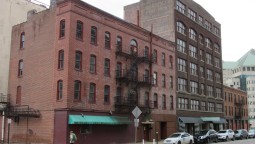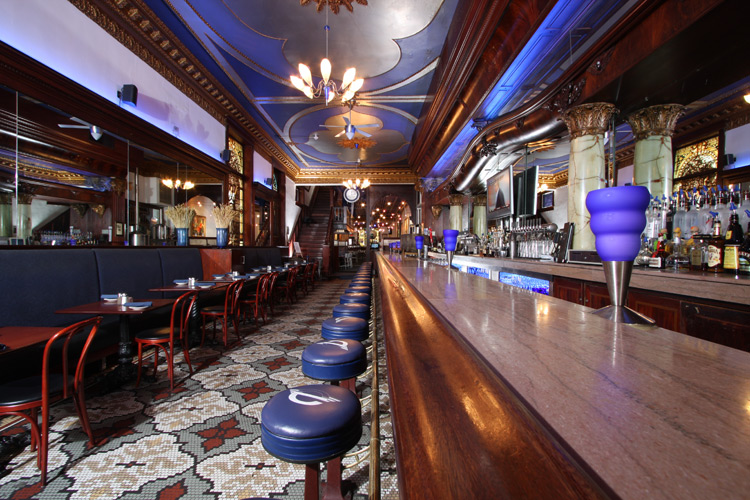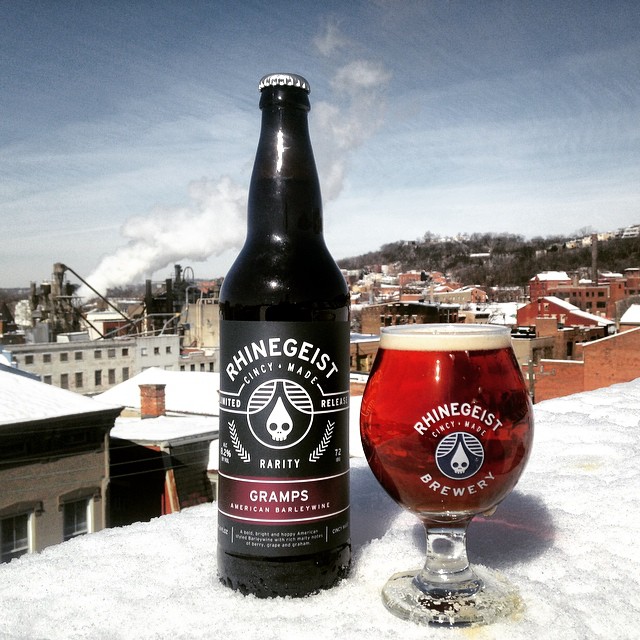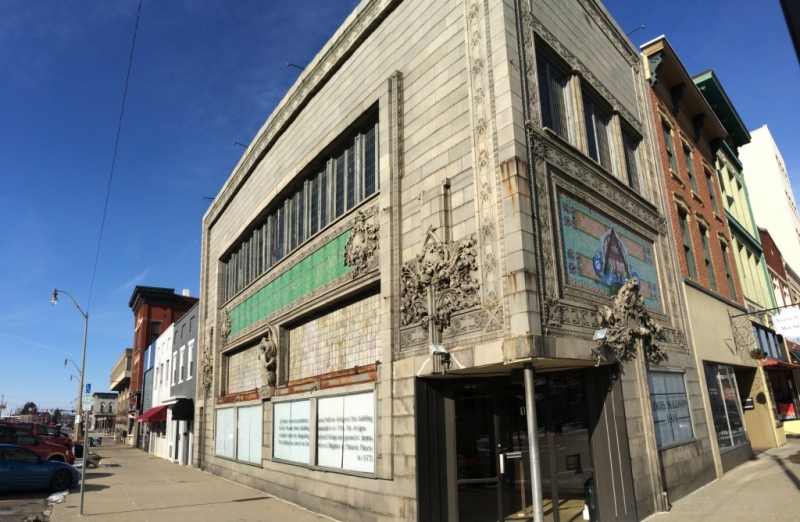ODSA releases list of Round 15 OHPTC recipients
This morning at the Drexel Theatre in Bexley, the Ohio Development Services Agency released its list of state tax credit recipients. With total project costs ranging from $300,000 to $270 million (yes, really…270 million dollars), the OHPTC program shows its worth to the big projects in the 3 Cs of Ohio, as well as in the smaller, courthouse communities. Congratulations to all of this round’s recipients! Read the ODSA release here.
Advocacy Alert: Proposed tax credit act needs your support!
To the excitement of preservationists across the country, the Historic Tax Credit Improvement Act (HR 3846) was introduced Wednesday, October 28. So why the excitement? For starters, HR 3846 offers the following tax credit improvements:
1) Small deals (less than $2.5 million in qualified rehabilitation expenditures) would see the eligible credit jump from 20% to 30%.
2) Transfer of credits as a tax certificate could give owners of smaller projects greater flexibility to bring in investors, and make capital easier to access.
3) Substantial rehabilitation (the threshold for becoming eligible to take advantage of the credits) would drop to 50% of the adjusted basis from the current 100%.
Add in better treatment of state tax credits when it comes to federal taxation, and other improvements, and you can begin to see how these changes, if passed, could inject a wave of new investment for countless small project rehabs.
Here in Ohio, we have Representative Pat Tiberi, and Representative Mike Turner to thank for helping lead the way as original co-sponsors of the bill, but we’re reaching out to you today, to encourage you to contact your representative, to ask him or her to sign on as co-sponsors for HR 3846 (or to thank Reps Tiberi and Turner for their support). You can find your representative here.
Check out this one-pager from the Trust, which summarizes the bill and how it improves the current federal historic tax credit.
Have you checked out the Building Technology Heritage Library?
When it comes to historic preservation weaknesses, I have a few (ie, many). And right up at the top of the list are plan books. These historical publications may have covered contemporary house plans, painting palettes, or more esoteric subjects such as cast iron storefronts. As an example, Sears was going all out during the first half of the 20th century, hawking their “Honor-Bilt” homes in their ubiquitous catalogs.
I love perusing these plan books because they provide great insight on what people were building or using, and can provide good rehabilitation inspiration. So, you can imagine my excitement at being reminded about the Building Technology Heritage Library, the multi-year project from the Association for Preservation Technology to digitize these resources and make them available through the Internet Archive. Now, all you need is an internet connection to review the Sears 1936 catalog (go ahead, see what Sears had to offer here) and literally thousands more. Happy online reading!
Lakewood Alive leads restoration process for 1446 Mars Avenue home
While the majority of our Ohio Main Street Programs devote 100% of their time to improving their respective downtowns, some programs have begun dipping their toes into the residential revitalization pool. Main Street Wooster helped make the Howey Houses project a reality, and Main Street Medina recently completed its Renew Medina project to give new life to a neglected residence adjacent to the downtown.
Now, Lakewood Alive has teamed with Detroit Shoreway to rehab a former boarding house back into a single-family home. You can learn more about the home’s happy outcome here (and make sure you check out the Before/After image gallery at the bottom of the post).
Although downtown revitalization programs have traditionally focused their resources solely on work to improve the business district, we’ve come to learn that the downtown’s health is more often than not inextricably tied to the health of the surrounding neighborhoods, including the residential neighborhoods that ring the downtown. Programs that have forged community partnerships, and that have the financial and human resources to take on these special projects, are finding that their mission-driven accomplishments sometimes happen outside of the downtown, as well as in the downtown.
Ohio Historic Preservation Tax Credit saved!
Update (6/16/15): Senators have removed language applying a moratorium on the successful OHPTC program! Thank you! Your messages touting the economic power of the tax credit resonated loud and clear among the Ohio Senate.
Yesterday, the Ohio Senate proposed to eliminate the Ohio Historic Preservation Tax Credit (OHPTC), with the possibly of transitioning it into a grant program several years from now.
This highly successful economic development program, without prior discussion, is in jeopardy of disappearing. Without the OHPTC Program, Ohio would not have had more than 1.4 billion dollars invested in the state, in the process rejuvenating countless abandoned or blighted buildings. The OHPTC promotes economic development at its finest: creating income-producing, taxpaying, and neighborhood-contributing buildings.
Since the program’s inception in 2007, the tax credit program’s investment statistics speak for themselves: 7 million square feet of redeveloped building space; 3,429 new housing units created; and an overall ROI of $6.70 for every dollar of tax credit generated.
To help save the Ohio Historic Preservation Tax Credit Program, we need you to do two things TODAY. Please email Senator Oelslager, Chair of the Senate Finance Committee, Senator Peterson, Chair of the Senate Ways & Means Committee, and your Senator to tell them why this will be detrimental to Ohio’s economic growth.
Thank you for helping us to send the message about the tax credits where it’s needed most!
Preservation Month Photo Contest | And the winner is…
Thank you to everyone who voted this year, and congratulations to Judith Khaner, this year’s winner!
Judith’s winning image features the interior of the Arcade, a Cleveland landmark revitalized for shops and hotel use in the early 2000s. As this year’s winner, Judith’s image will be featured on a future issue of Revitalize Ohio.
Whether entering our contest or voting for a winning entry, we hope you’ll join us next year for Preservation Month for our 2016 Photo Contest.
Here’s Judith’s winning entry:
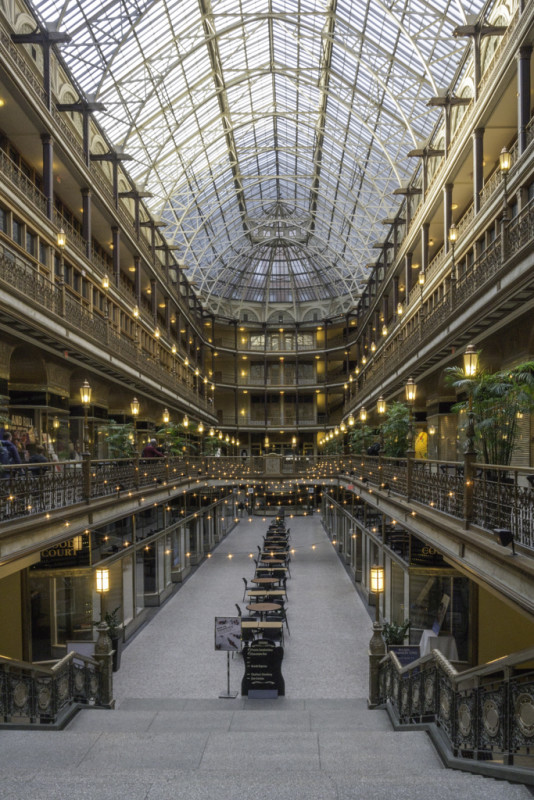
Preservation + Pints (Or Shots)
By Sarah Marsom
Craft breweries and distilleries have swept Ohio by storm. Many breweries are hoping to revitalize the state’s history as a beer capital, and many distilleries are using historical beverages to inspire their contemporary palates. Here are a few places you should try!
Elevator Brewery and Draught Haus (Columbus)—both a popular bar and eye catching building in Columbus. Elevator Brewery’s history dates back to 1897. Located in the Bott Brothers’ Billiards building, this contemporary bar thrives on its historical elements—the billiards tables from the 1800s, stained glass entry, tile floors, decorative ceilings, and a well preserved bar. The Elevator Brewery and Draught Haus is listed in the National Register of Historic Places as part of the Columbia Building. You can go to www.elevatorbrewing.com for more information.
Rhinegeist (Cincinnati)—Rhinegeist means “ghost of the Rhine”, and bringing a ghost back to life is exactly what this beer company did! Located in the historic Over-the-Rhine brewery district, Rhinegeist is revitalizing the beer industry, which made the area thrive in the late 1800s. Prohibition put 38 breweries out of business and left countless German immigrants unemployed. In the recent past, developers have been revitalizing the Over-the-Rhine neighborhood; Rhinegeist has sparked new life into Christian Moerling Brewing Company’s old bottling plant. Want to learn more about the building’s history and Rhinegeist? Take one of their guided tours. You can learn more at www.rhinegeist.com.
*Cincinnati is also home to underground brewery tours! This town’s beer history is deep!
Homestead Beer Co (Licking County)—while the brewery is not in a historic building, Homestead Beer Co has its headquarters in the very historic community of Granville, and the name evokes wonderment of the original farm settlements, which created a thriving Licking County in the 1800s. Homestead Brewing does not use modern yeast strains, instead preferring yeast which could have been used by grandfathers of the past to brew. With brew names such as 1805, Five Points Irish, and Barnraiser, one knows the people behind Homestead use the past as inspiration to create contemporary drinks. Go to www.homesteadbeerco.com to learn more.
E.S. Distillery (outside Fremont)—located in a 120-year-old barn, the Ernesto Scarano distillery is worth a visit. This craft distillery is supposedly the smallest legal whiskey distillery in America. Www.esdistillery.com for more information.
What are some of your favorite bars, breweries, or distilleries in Ohio with historic elements? Add your favorites to the list in the comments section below.
Your Krogering can help support Heritage Ohio
Yes, you can shop and assist Heritage Ohio at the same time, and it’s easy to do. Once again, Heritage Ohio is a nonprofit partner in Kroger’s Community Rewards program. What does that mean? Quite simply, each shopping trip to Kroger means a small donation for Heritage Ohio. And those small donations really add up. In fact, we’ve received over $1,200 to date, from people doing their everyday shopping at Kroger!
We’d love to have you as part of our Kroger shopping army, benefiting Heritage Ohio with each purchase. It’s easy to set up your Kroger Plus Card to direct your Community Rewards to Heritage Ohio. Just go to www.krogercommunityrewards.com and click the “Sign-In” button (if you haven’t registered your Kroger card yet, you can also do that from their website).
Then, go to the Community Rewards heading, toward the bottom of the page, and enter Heritage Ohio to search for us (or enter our Community Rewards ID which is 81631). Once Heritage Ohio comes up, click on “Enroll” and you’ll be set for the year.
Now, with every head of lettuce or gallon of milk you buy, you’re helping us to save the places that matter, build community, and live better. Thank you!
You can learn more and sign up here. If you sign up, let us know, so we can give you a proper thanks!
Our Preservation Month Photo Contest is open!
Our annual Preservation Month Photo Contest has opened, and we’ve extended the entry deadline to May 29! You can learn more about the contest here.
For inspiration, check out one of our finalist images from 2013, photographed by Antony Seppi. As the metal covering of this downtown Hamilton building is removed, the architectural richness of the facade begins to shine through.
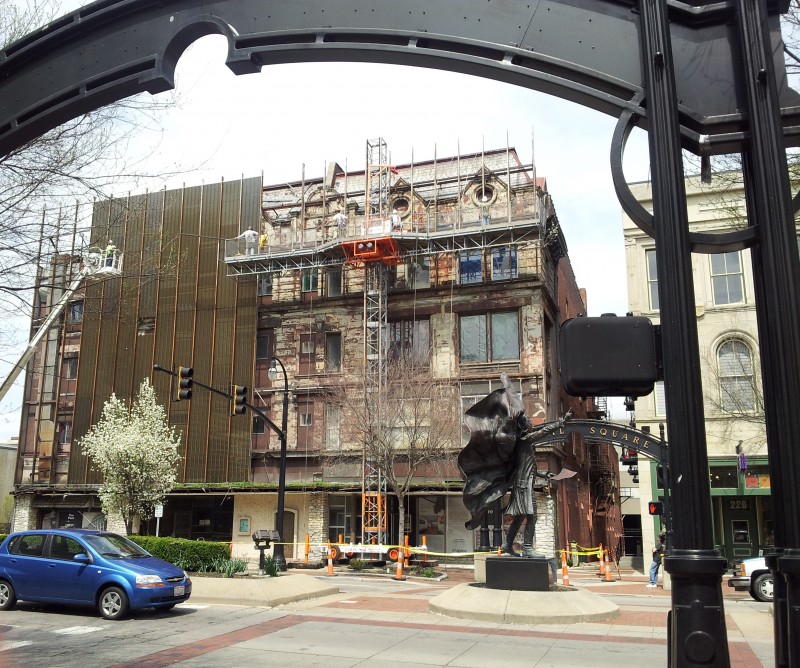
A sneak peek into what YOP is planning
We’re excited to start a new blog series this month, with preservation perspectives written by Young Ohio Preservationist members. Sarah Marsom, the YOP chair, kicks off the series this month.
The Young Ohio Preservationists are new to the scene and excited for 2015. We have already hosted a successful tour of the Cristo Rey Columbus High School, which was an exciting multi-million dollar tax credit project, and we had an engaging window restoration workshop, where we fixed all of the historic windows in a Dutch Colonial home in the Westgate neighborhood of Columbus.
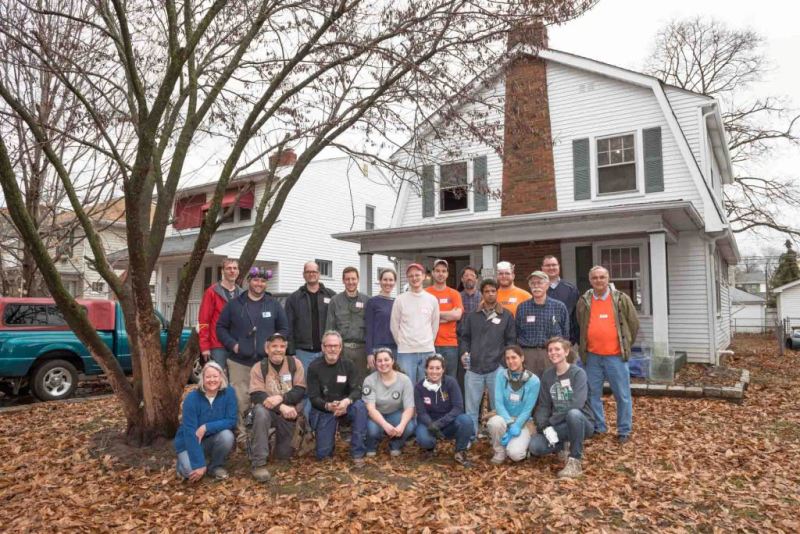
Attendees of the windows workshop gather outside the Westgate home. Photo courtesy of Stephen Newport.
It is the Young Ohio Preservationists board’s goal to provide unique experiences to both recreational and professional preservationists. And if you are wondering if you are too old to participate, do not worry! We invite people of all ages to engage with us.
Throughout the year we will be rolling out exclusive events, but here is a sneak peek for two experiences you cannot miss out on!
On April 25, the Young Ohio Preservationists are taking Newark by storm. The Licking County Foundation has invited us to tour the Louis Sullivan designed Home Building Association Bank, and they are coordinating some bonus historic building tours exclusively for the YOPs! Following the tours, we will be hosting a design charrette and helping the foundation brainstorm the best adaptive use opportunities for the Sullivan designed bank.
As part of the Green Lawn Abbey CLG grant, the YOPs will be hosting a marble cleaning workshop. Green Lawn Abbey is a 1927 neoclassical mausoleum listed in the National Register of Historic Places and has been undergoing a restoration for a number of years. The Centennial Preservation Group will teach participants the best practices for marble cleaning. Our assistance will bring Green Lawn Abbey one step closer to renting the space for events and creating a sustainable income source for maintenance.
Make sure to follow us on Facebook, Instagram, or join our mailing list by emailing yop@heritageohio.org to make sure you know about our events!
![]()
Seven rules for success when reconditioning wood windows
Last weekend I had the privilege of attending one day of the two-day wood windows workshop put on by Young Ohio Preservationists. Led by restoration artisans Jim Turner and Patrick Kennedy, attendees had the opportunity to learn (or hone) their skills, whether removing sash (without damaging the surrounding wood components), stripping out old glazing, removing paint, reglazing the sash, or repairing damaged sash ropes. Both Jim and Patrick are experts who have forgotten more about restoring old windows than most of us will ever learn, and both shared a lot of great advice over the course of the day. Here are some tips you can use when tackling your own wood window restoration project.
1) Parts for repairs. Where do you get window parts for storms? Try Blaine Window Hardware. The instructors have sourced many a hard-to-find item from them.
2) Aluminum storm makeover. Tired of the look of your old aluminum storms? Before you consider tossing them, consider paint. Paint specifically formulated to coat aluminum has come a long way, and more colors than ever are available. Now, instead of dull, silvery outlines for your windows, you can consider a color that actually complements your home’s existing paint scheme.
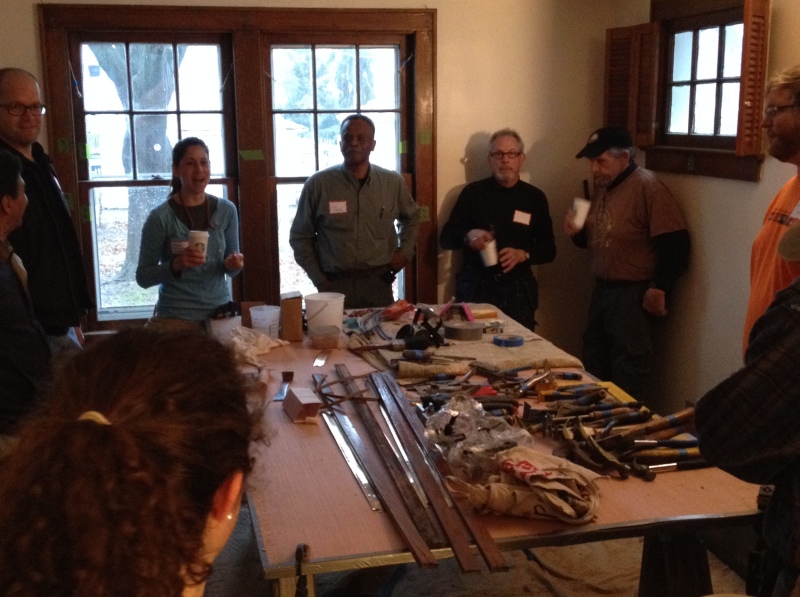
Jim Turner, center, of Turner Restoration, pumps up workshop attendees Saturday morning with equal parts knowledge and inspiration.
3) Steam stripping. Consider a garment steamer (yes, a garment steamer) for stripping your sash. If you’ve ever stripped paint, you know it can be a messy job. As if the mess is bad enough, you also have to guard against removing paint that’s potentially lead-based. Sanding and scraping can release dangerous particulates, but steam stripping keeps airborne paint dust to an absolute minimum. From past experience, I’d recommend against using the Wagner Power Steamer. The Wagner model tends to spit out a lot of hot water, in addition to the steam. Instead, try a product like the Rowenta Commercial Garment Steamer (available from target.com here). Jim Turner brought his garment steamer, and it was all steam, no hot water, which made for a lot less mess. If you have a house full of windows or woodwork to strip, it’s worth the $100 investment to do it safely.
4) A better way to fish sash cord. Fishing sash cord, when you’re ready to reinstall your sash, can be a frustrating experience, as you try to loop the cord over the pulley, through the weight pocket, and down to the weight pocket door. The sash cord is so light that it bends and gets caught up on obstructions in the weight pocket, never making it to the bottom where you can tie on the sash weight. Instead, start with a length of metal chain taped to the sash cord. The metal will provide the needed weight to allow the cord to drop right to the bottom of the weight pocket.
5) Securing the sash cord to the sash. To secure the knotted end of the sash cord in the sash, insert a screw through the knot into the wood, instead of hammering a nail through it. A screw is much easier to remove in the event you need to remove the sash out of the window frame.
6) Refreshing your wood sash. You can refresh old, dry wood, prior to painting, with a recipe of 1/2 gallon turpentine, 1/2 gallon boiled linseed oil, and 1 ounce of paraffin. The linseed oil will rejuvenate the wood fibers, and the paraffin will act as a decent water barrier. The turpentine is the vehicle to deliver the linseed oil and paraffin into the wood, so it can soak in.
7) Saving your parting stop. The parting bead, or parting stop, is the bane of window restorers everywhere, because it’s so easy to snap them while you’re working to remove the sash. Instead of using vise grips or pliers to try to pull out the parting stop, try vise grips with long jaws. The increased surface area means there’s less chance of marring the parting stop, while spreading out the pressure point, meaning less chance of snapping the stop as you try to wiggle it loose. (Give me a pair of these, and I feel like I could conquer the window restoration world!)
While there’s a lot of practice, knowledge, and equipment, that goes into proper window restoration, having some tricks of the trade up your sleeve can make the process easier, and, actually, fun. And rewarding.
Do you have a great window restoration story to tell? Would you like to see another hands-on workshop? Let us know. Thanks for reading!


